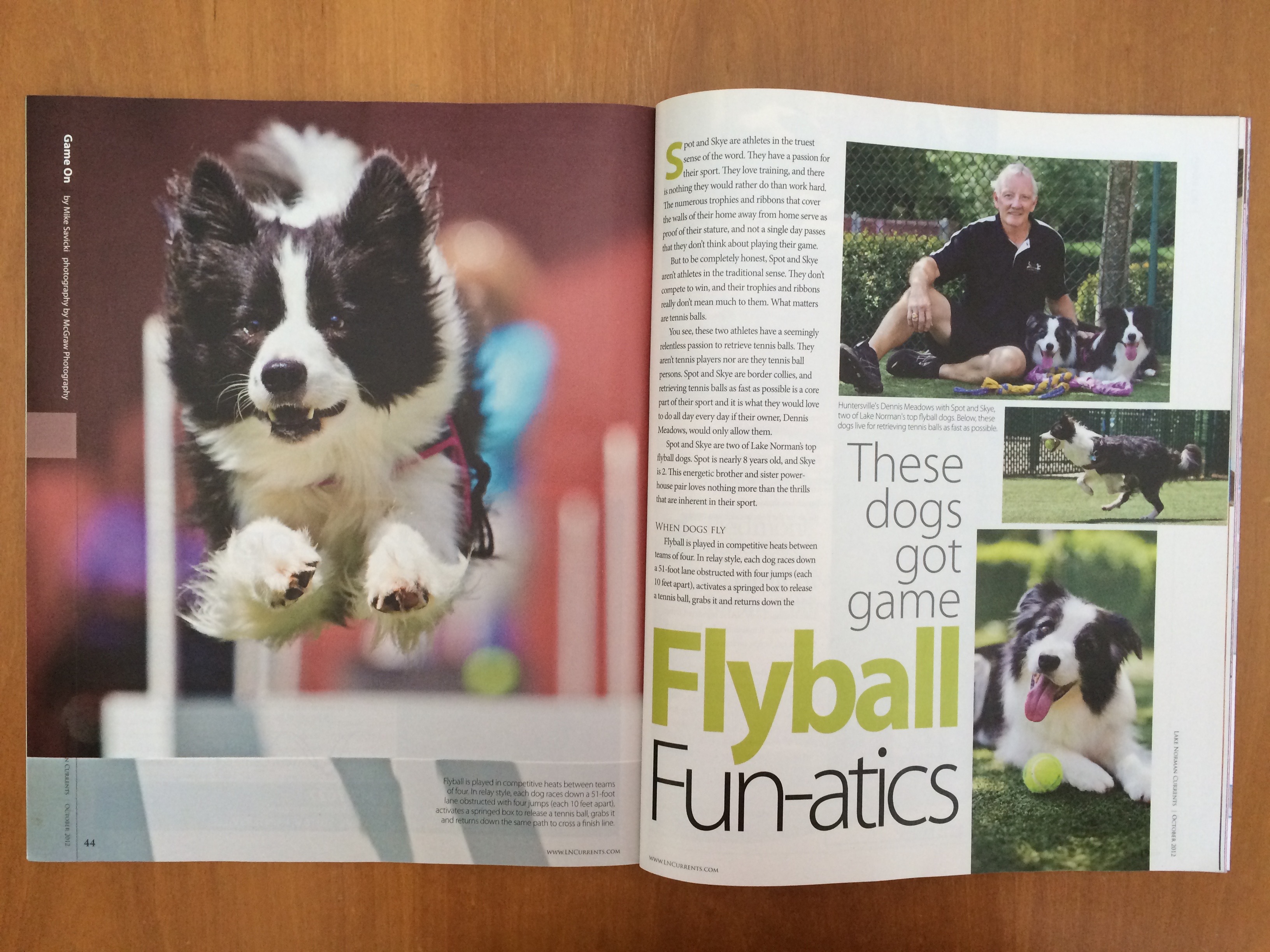Flyball Fun-atics
These dogs got game
By Mike Savicki
Spot and Skye are athletes in the truest sense of the word. They have a passion for their sport, they love training and there is nothing they would rather do than work hard. The numerous trophies and ribbons that cover the walls of their home away from home serve as proof of their stature, and not a single day passes that they don’t think about playing their game.
But to be totally honest, Spot and Skye aren’t athletes in the traditional sense. They don’t compete to win and their trophies and ribbons really don’t mean much to them. What matters are tennis balls. You see, these two athletes have a seemingly relentless passion to retrieve tennis balls. They aren’t tennis players nor are they tennis ball persons; Spot and Skye are border collies and retrieving tennis balls as fast as possible is a core part of their sport. It is what they would love to do all day every day if their owner, Dennis Meadows, would only allow them.
Spot and Skye are two of Lake Norman’s top flyball dogs. Spot is nearly eight years old and Skye is two. This energetic brother and sister powerhouses pair love nothing more than the thrills that are inherent to their sport.
When dogs fly
Flyball is played in competitive heats between teams of four. In relay style, each dog races down a 51 foot lane obstructed with four jumps each 10 feet apart, activates a springed box to release a tennis ball, grabs it and returns down the same path to cross a finish line. Spot and Skye compete as relay members on different teams of four. It takes each of them just over four seconds to blaze through the course.
The sport got its start in the ‘60’s and ‘70’s when a group of Southern California dog trainers invented a hurdle relay sport to keep their active dogs busy. A demo on the Johnny Carson Show then introduced it to America. The first competition took place in 1983 and the North American Flyball Association (NAFA) formalized the sport in 1984. Flyball has now grown to include over 400 registered clubs and 6,500 competing dogs. NAFA sanctions more than 300 competitions each year.
As it has grown, flyball has borrowed a few tricks from other sports. Each heat begins as a red-yellow-green lighting system, similar to drag racing, flashes to start the clock. The four jumps the dog must clear resemble miniature track hurdles. From the sport of swimming, dogs have borrowed and modified the flip turn for maximum speed, efficiency and safety.
And the name of the sport? Some say it was coined from the passing motion of the original launch box that sent the tennis balls flying into the air for the dogs to catch and retrieve.
See Spot run
“My dog [Spot] is the reason I do this,” says Dennis Meadows, owner of the twelve-year old Meadows Bed and Biscuit in Huntersville, and founder of Max Fast Flyball, Charlotte and Lake Norman’s only NAFA registered flyball organization. “It makes my dog happy, and because he’s happy, he trained me to love the sport, too.”
Meadows also says it was Spot’s facial expression that convinced him flyball was the right sport choice for his border collie.
“Spot was trained as an agility dog first, but he never seemed to look happy in the pictures we took,” Meadows shares. “But I looked at him in a picture at his first flyball tournament and he just looked happy. I knew he was having fun. And now you’ll always see him a happy dog in flyball photos.”
Spot’s record speaks for itself. He is well known across NAFA Region 9, comprised of North and South Carolina, Virginia and West Virginia, and one of the sport’s 22 regions in the United States and Canada. Spot has earned enough points to be called a flyball master, the highest designation an athlete receives. And now, as an older dog, he has earned the right to compete on veteran teams where a smaller schedule helps minimize the stresses and strains on his body.
See Skye fly
Spot’s younger sister, Skye, is following in her older brother’s paw prints and is rapidly ascending the flyball ranks. After less than two seasons, Skye has earned flyball champion gold, the designation before flyball master. She is a reliable start dog who is picking up speed and technique as fast as she gains her performance points.
How fast is Skye? The best flyball dogs in the world complete the course without error in a dog’s hair over four seconds. Skye reliably hits 4.2 seconds.
Dennis Meadows says starting a dog in flyball requires a sizable time commitment that Skye was more than happy to embrace. He offers, “It’s a similar commitment to what parents feel when they enter a son or daughter in a travel sport. You have to commit to weekly practices and classes then travel to tournaments and hotels and get used to being on the road.”
Meadows adds, “I waited to enter Skye until her growth plates had fully formed and she was old enough to race safely. After watching Spot in the sport, you know she was quick to follow.”
Spot and Skye now compete in about one tournament each month, and when they aren’t on the road, they are training. And if these athletes had their say in the matter, the training would never end because sport fuels life and, as any dog owner will tell you, there is always a tennis ball out there waiting to be retrieved.
This article was originally published in the October 2012 edition of Currents Magazine.

